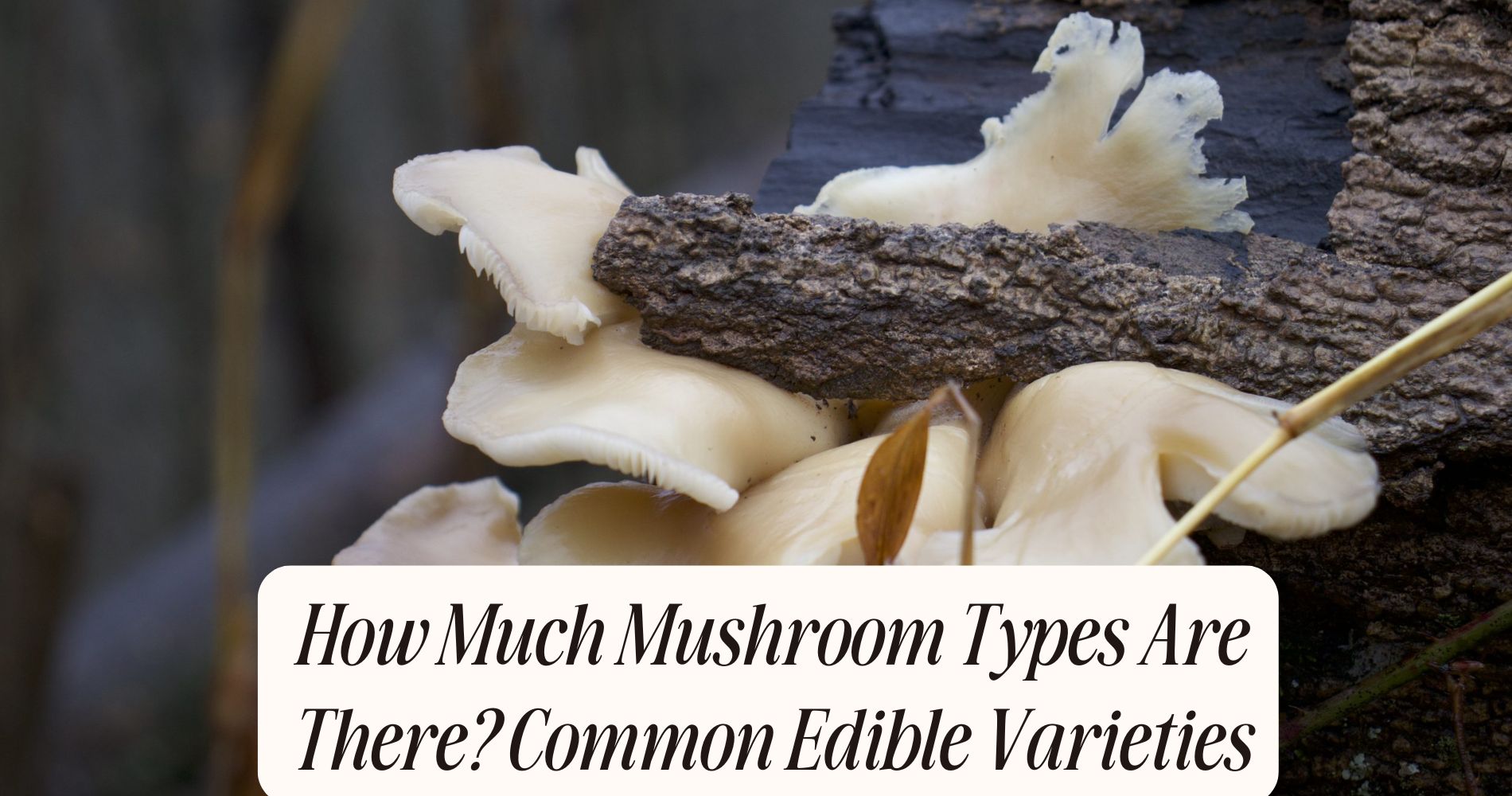
How Much Mushroom Types Are There? Common Edible Varieties
How much mushroom types are there? When it comes to edible mushrooms, you'll find a diverse range available. Common varieties include button mushrooms, portobello, shiitake, chanterelle, morel, and oyster mushrooms. Each type boasts unique flavors and textures, enhancing culinary experiences. Button mushrooms are versatile, while portobello offers a meaty texture. Shiitake is known for its umami depth, and chanterelles entice with their delicate taste. Furthermore, morels and oyster mushrooms provide distinct qualities beneficial for health. Explore further to discover more fascinating mushroom varieties and their uses.
Button Mushrooms
Button mushrooms, scientifically known as Agaricus bisporus, are among the most commonly consumed fungi worldwide. You’ll find several button mushroom varieties, including the white, cremini, and portobello, each offering distinct flavors and textures.
Button mushroom cultivation is a well-established process, often utilizing controlled environments to optimize growth conditions. The cultivation begins with sterilized substrates, typically composed of composted materials, where mycelium is introduced. This mycelium colonizes the substrate, leading to fruiting body formation under specific humidity and temperature conditions.
Understanding these factors is essential for achieving high yields. As you explore button mushrooms, consider their versatile culinary applications and nutritional benefits, making them a staple in various dishes across cultures.

Portobello Mushrooms
Portobello mushrooms aren't only rich in nutrients but also versatile in culinary applications.
You’ll find that their meaty texture makes them ideal for grilling, roasting, or stuffing in various recipes.
Understanding their nutritional benefits and how to grow them can enhance your cooking and gardening experience.
Nutritional Benefits Overview
While you might think of mushrooms as mere culinary additions, Portobello mushrooms offer a remarkable array of nutritional benefits that can enhance your diet.
These mushrooms are low in calories yet rich in essential nutrients, providing a robust nutrient profile that includes B vitamins, selenium, and potassium. Their high fiber content promotes digestive health, while antioxidants like ergothioneine contribute to cellular protection.
The health benefits extend to potential anti-inflammatory and immune-boosting properties, making Portobello mushrooms a valuable addition to your meals. Additionally, their unique umami flavor can help reduce the need for added salt, supporting heart health.
Incorporating Portobello mushrooms into your diet not only diversifies your meals but also maximizes your nutrient intake.

Culinary Uses and Recipes
When considering versatile ingredients for your meals, Portobello mushrooms stand out due to their meaty texture and rich flavor, making them an excellent choice for a variety of culinary applications.
Their robust flavor profile complements a range of mushroom pairings, such as garlic, thyme, and balsamic vinegar, enhancing both vegetarian and meat-based dishes. You can grill, roast, or sauté Portobello mushrooms to create hearty burgers or flavorful stir-fries.
Additionally, they work well in risottos and salads, providing a satisfying bite. For an elevated dish, try marinating them in soy sauce and stuffing them with cheese or spinach for an impressive entrée.
Their adaptability in recipes showcases their unique ability to enhance and elevate your culinary creations.
Growing and Harvesting Tips
Growing Portobello mushrooms requires attention to specific environmental factors to guarantee a successful crop.
Start with soil preparation; use a rich, well-draining substrate, ideally a mixture of composted manure and straw. Maintain a pH level between 6.0 and 7.0 for ideal growth.
Temperature is essential—aim for 70-75°F during colonization and 55-60°F for fruiting.
For pest management, regularly inspect your setup for signs of pests like aphids or mites, which can hinder growth. Implement organic pest control methods, such as neem oil, if necessary.
Monitor humidity levels, keeping them around 80-90% during fruiting.
When harvesting, twist the mushrooms gently to avoid damaging the surrounding mycelium. This careful approach will maximize your Portobello yield.
Shiitake Mushrooms
Shiitake mushrooms, known for their rich umami flavor and meaty texture, are a popular choice among culinary enthusiasts and health-conscious individuals alike.
You’ll find that shiitake cultivation primarily involves growing these fungi on hardwood logs or sawdust, mimicking their natural habitat. This method not only enhances their flavor but also promotes a sustainable approach to mushroom farming.
From a health perspective, shiitake mushrooms boast numerous benefits; they’re high in polysaccharides, particularly lentinans, which may boost your immune system. Additionally, they contain essential vitamins and minerals, contributing to overall wellness.
Incorporating shiitake mushrooms into your diet can enhance the nutritional profile of your meals while delighting your taste buds with their distinctive flavor and texture.

Chanterelle Mushrooms
Although often sought after for their delicate flavor and stunning golden color, chanterelle mushrooms are more than just a culinary delight; they're also a fascinating subject of study in mycology.
When foraging for these prized fungi, you'll want to employ specific chanterelle identification tips: look for their trumpet-like shape, wavy edges, and vibrant yellow-orange hue. Pay attention to their gills, which are forked and run down the stem.
For chanterelle foraging safety, make sure you avoid look-alikes, such as the toxic Jack-o'-lantern mushroom, by examining spore prints and habitat. Always consult a reliable field guide or expert before consuming wild mushrooms.
With proper knowledge and caution, you can safely enjoy the unique flavors of chanterelles in your culinary creations.
Morel Mushrooms
Morel mushrooms are another highly sought-after variety, prized for their unique texture and rich, earthy flavor.
To guarantee successful foraging, you need to focus on morel identification. These mushrooms feature a distinctive honeycomb appearance, with a hollow stem and cap. Their color ranges from light tan to dark brown, depending on the species.
Morel season typically spans from late March to early June, varying by region and climate. During this time, you'll find them emerging in wooded areas, often near dead or dying trees.
Remember to avoid false morels, which can be toxic. By mastering morel identification and understanding their seasonal patterns, you can enhance your culinary adventures with these delicious fungi.
Oyster Mushrooms
When exploring the world of edible mushrooms, oyster mushrooms stand out due to their delicate texture and mild, slightly sweet flavor.
These fungi thrive in a variety of substrates, making oyster mushroom cultivation both accessible and sustainable. You can grow them on straw, sawdust, or even coffee grounds, allowing for efficient recycling of organic waste.

Nutritionally, oyster mushrooms are a powerhouse; they’re low in calories yet rich in essential nutrients. They provide a good source of protein, fiber, and B vitamins while being packed with antioxidants.
Their health benefits include potential cholesterol-lowering effects and immune system support. Incorporating oyster mushrooms into your diet not only enhances flavor but also contributes positively to your overall health.
10 Mushroom Types, One Delicious Gummy: SUPER MUSHROOM GUMMIES
After exploring how much mushroom types are there, why not try a blend of the best in one simple, tasty form? Well Gummies' SUPER MUSHROOM GUMMIES combine 10 carefully selected functional mushrooms—each chosen for its unique health benefits—into a convenient, chewable gummy. These vegan gummies support brain function, immune health, and calm, steady energy with no jitters or crash. With a fresh wild berry flavor as satisfying as your favorite candy, it’s never been easier to enjoy the power of mushrooms every day. Experience full-spectrum wellness with every bite!
Frequently Asked Questions
Are There Any Poisonous Mushrooms That Resemble Edible Varieties?
Yes, many poisonous mushrooms resemble edible varieties. You must focus on mushroom identification to avoid dangerous lookalikes. Familiarize yourself with key characteristics, as even experienced foragers can sometimes misidentify these hazardous species. Stay cautious!
How Should I Store Fresh Mushrooms for Longevity?
To store fresh mushrooms for longevity, use refrigeration techniques like placing them in paper bags for moisture control. Avoid plastic, as it traps humidity, leading to spoilage. Maintain a cool, dry environment for ideal freshness.
Can Mushrooms Be Grown at Home Easily?
Yes, you can grow mushrooms at home easily using mushroom kits. These kits provide everything you need for home cultivation, simplifying the process while ensuring ideal conditions for growth, such as humidity and temperature management.
What Are the Health Benefits of Mushrooms?
Mushrooms offer numerous health benefits, including immune support and high nutritional value. They’re rich in vitamins, minerals, and antioxidants, helping enhance your overall health while potentially reducing the risk of chronic diseases.
How Do I Clean Mushrooms Before Cooking?
To clean mushrooms effectively, use mushroom cleaning techniques like gently brushing off dirt or rinsing briefly under cold water. The best cleaning methods help preserve flavor and texture while ensuring your mushrooms are safe to cook.
Conclusion
In conclusion, the diverse world of mushrooms offers a variety of edible types, each with unique flavors, textures, and nutritional benefits. From the familiar button and portobello to the more exotic shiitake and chanterelle, understanding these common varieties enriches your culinary experience. You’ll appreciate their distinct characteristics and versatility in dishes, enhancing both taste and health. By exploring these options, you can expand your palate and incorporate more fungi into your diet, benefiting from their remarkable properties.




